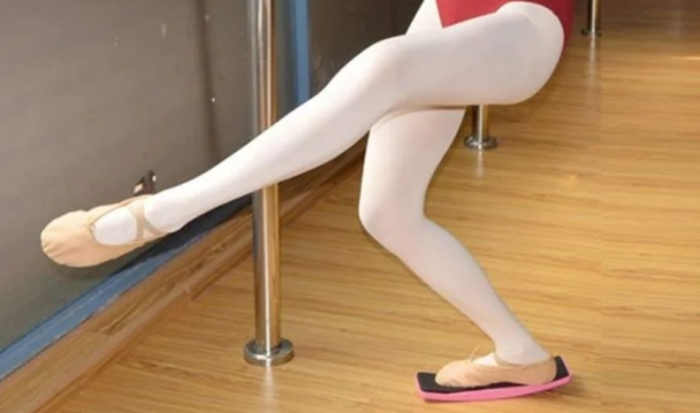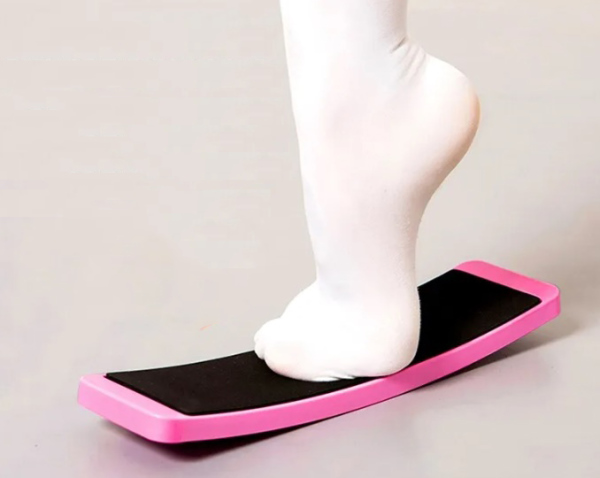A turning board for dancers seems to be a miracle with how much it can help them, despite the extremely simple appearance. How much of the myth is true? Can it truly improve your skills? How to use it accurately and achieve the best results? Everything you need to know about turnboards is right here!
Table of Contents
What Is A Turning Board For Dancers?
When a dancer attempts multiple turns, their weight and the floor create a remarkable friction that prevents them from turning smoothly. The main purpose of a turn board is to reduce this friction and prolong the duration of a dancer’s pirouette.
This seemingly magical tool has a rectangular shape – the width is about 3 inches (about the width of our foot or a smartphone) and the length is around 12 inches. However, they are usually manufactured with a slight curve instead of a flat form.
Originally created for ice-skaters to defy intuitive dizziness when they do multiple rotations, the main materials for turn boards are plastic compounds. But wood has been in use more since the boards became popular among dancers.
Check more: What Is Rosin For Dancers?
Benefits Of Turning Boards
Turnboards are good for dancers when they want to do better. The design allows them to spin faster and achieve more rotations due to the reduced friction against the floor.
While they are spinning faster than they often do, the sense of imbalance will be much stronger, which pushes them to adjust their posture and improve their stability during and after the turns.
For beginners ballet dancers
Even a non-dancer might enjoy the satisfaction of spinning around, so a beginner can certainly use turn boards without difficulty.
However, it comes with caution.
New dance students need to learn the basics of how to perform rotations with the right techniques. These basics usually don’t involve turning motions, hence there is no real need for turning boards.
You can let your little dancer play with the boards as a source of inspiration and additional practice once you are sure they can maintain the balance. It can help with core strength and balance if used reasonably.
For professional dancers
Advanced but young dancers might get a physical or mental block when they encounter a plateau, meaning a state of no change or improvement after a while, even though they have been practicing diligently.
Even professional dancers who are familiar with the correct techniques from the beginning won’t have an easy time increasing the number of rotations they can do in pirouettes. The plateau is completely understandable here.
An additional 2 – 3 turns are all they need to let their bodies grow accustomed to the feeling and figure out a solution for the predicament. This is when they can benefit from a turning board.
Turn Board vs Turn Disc
They share the same purpose for dancers: decrease the friction between the foot and the floor for easier rotation. The goal dancers have in mind when using these tools is unchanged, which is to spin and turn faster and better.
Unlike turn boards, the turn disc takes a circular shape with a diameter of 5 – 6 inches. It has foam padding on top for more support and comfort. You have learned the first difference between them!
Another difference is that turn boards are not meant for relevé, yet turn discs are. Due to the circular construction, the distribution of weight and gravity is more thorough and even than what the boards can offer. And the area of contact simply forces the dancers to stand in relevé.
Pros & Cons of Turn Boards
Pros:
- Decrease the friction between the foot and the ground.
- Help the dancers find confidence and detect the center of themselves while doing multiple rotations.
- The dancers can learn more about weight placement.
- Let the dancers grasp the way to do various turns.
Cons:
- Not designed for relevé.
- It feels a bit wobbly for dancers who haven’t mastered the basics of turning techniques.
- The dancers might develop a bad habit of turning on their heels instead of the foot’s front.
Pros & Cons of Turn Discs
Pros:
- Minimize the friction between the foot and the dance floor.
- Help the dancers find confidence while getting into relevé.
- Force the dancer to familiarize themselves with more pressure on the front of their foot.
- Specifically made for relevé, so the dancers are less likely to end up with inaccurate techniques.
Cons:
- It is very difficult to maintain balance on the front of your foot if you are not skilled in basic turns.
- The disc can turn much faster than expected, so prepare yourself for the speed here!
How To Use Turn Boards?
The curved shape of a turn board opens up the chance for you to improve your technique and strengthen your core. There are two primary ways for you to utilize your board.
Flat Mode
When going for the flat mode, your foot should be placed on the board in a way that your longest toe and your heel are evenly spaced away from the two ends of it.
Make sure the center of your foot is balanced enough, or the risk of tripping and falling will be very high.
The heel section of turning boards usually has a rubber ring as the safety brake, so the dancer has the necessary protection. You can spin as much as you are capable of, the arched structure and the rubber brakes will come in handy only when you stumble.
Relevé Mode
If you have been training your balance and strength for a while and want a challenge, you can try the relevé mode instead!
The key in relevé is that you only have the ball of your foot on the turn board, hence you need to place yourself on the center of the board as accurately as possible.
The board should form a ‘T’ letter with your foot by the time you are ready. When you lean too much on one side, the board will not stay steady, resulting in falling.
Despite the possible benefits, turn boards weren’t made for relevé, hence they might give you bad habits in posture and willpower if you rely on them too much.
Extra Tips
- Don’t forget to engage your core!
- Avoid sitting on the supporting leg.
- If you are trying a turn board for the first time, take it slow. It can turn much faster than you expect and catch you off guard.
- Keeping your arms close to your torso and snapping your head in the same direction you turn. This can speed up the turns. So, be careful when you want to spice things up too!
When Should You Use A Turn Board?
To make good use of turn boards, you need to reach a certain level of dancing skills. In short, experts will tell you to master your pirouettes first.
Here are the keys you need.
- Balance: Your posture on one leg should be steady and straight, whether you are doing a flat or relevé move.
- Core strength: The back and abdominal muscles are essential to support your posture.
- Proprioception: When your body is moving in grand motions, your awareness of the connection between yourself and the surroundings should be clear.
- Spotting: Whip your head around and fix your eyes on the next direction of your turn so you won’t feel dizzy and lose balance.
- Turnout: The strength and flexibility to open your hips and maintain the proper posture.
3 Best Turning Boards for Dancers
If you are ready to invest in a turning board but unsure where to start, we might be bold and suggest some of the most decent turn boards for dancers that we have come across.
Cosmos Turning Board for Ballet
Available in bold pink and purple, Cosmos’ turning boards are already winning in the aesthetics aspect because these two colors are undeniably inspiring and pleasant for dancers of both genders.
Its structure has a carefully calculated curve so the friction with the floor will be minimized. Besides the thickened plastic platform, the EVA foam also contributes to the anti-slip properties, making the dancers feel safe and prolonging the board’s longevity.
Weighing only 6.3 Oz and measuring less than 12 inches in all dimensions, you can easily carry this board with you. The bottom of the board will leave no scratches on the marble and wooden floors.
Please be aware that the product wasn’t created for rough surfaces, hence it might be prone to damage if you try.
Pros:
- Durable plastic and EVA foam.
- Sleek design.
- Lightweight.
Cons:
- Not suitable for surfaces with some roughness
Zenmarkt Turning Boards for Dancers
Put your feet on the non-slip and smooth board and you will immediately feel the urge to practice.
The stability and the support you feel are proof of your safety, whether you are starting to learn turns or looking to improve the techniques you have grasped.
Made of soft EVA foam and nylon polymer, the Zenmarkt board functions well on smooth surfaces and leaves no damage to your fancy floors. However, the carpet will limit its performance.
For a better manual, the product also includes an eBook about the perfect pirouette and how to achieve it. Combined with the compact and lightweight design, you can bring the entire package along and practice anytime.
What we don’t like about this board is that, although it is said to support a maximum weight of 187 pounds for its dancers, it doesn’t feel stable enough for adults.
Pros:
- Supportive and stable.
- Lightweight and compact.
- An eBook is included
Cons:
- Not stable enough for adults or grown teenagers.
- Not for carpeted floors.
TTolbi Premium Turning Board for Dancers
Ttolbi ensures you reach your potential, be it for a passionate performance or a serious career. Once you have good control over your body, your confidence and stage presence will be something people cannot overlook.
With the combination of nylon and EVA foam, your feet will feel no slipping and the board’s bottom will encounter almost zero difficulty on both hard and carpeted floors. If you need your boards to always work on all surfaces.
By adopting a slender form with insignificant weight, you will never have to worry about not having your favorite tool when going on a trip.
However, despite the smooth turns this board offers, you won’t be free from scratches on your floor if you leave it bare. Compared to the price, this flaw might disqualify the board for some customers.
Pros:
- Fine EVA foam and nylon materials.
- Stable with no slip.
- It works on carpeted floors too.
- Light and slender.
Cons:
- Leaving minor scratches on the floor.
- A bit pricey
Final Words
Using a turn board for dancers is a great choice to get the core engaged and enhance the sense of balance. Many dancers confirmed that these boards help them grasp the feeling of various rotations and accurate spotting.
However, it’s best to keep in mind that no equipment can replace an accredited instructor and the dancer’s efforts. There is only so much turning boards can do for you!







